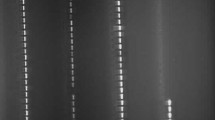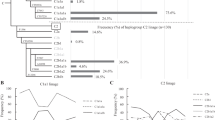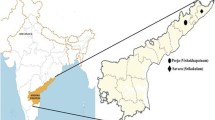Abstract
We have analyzed eight Y-chromosomal binary markers (YAP, RPS4Y711, M9, M175, LINE1, SRY+465, 47z, and M95) and three Y-STR markers (DYS390, DYS391, and DYS393) in 738 males from 11 ethnic groups in east Asia in order to study the male lineage history of Korea. Haplogroup DE-YAP was found at a high frequency only in Japan but was also present at low frequencies in northeast Asia, including 2.5% in Korea, suggesting a northern origin for these chromosomes. Haplogroup C-RPS4Y711 was present in Korea and Manchuria at moderate frequencies: higher than in populations from southeast Asia, but lower than those in the northeast, which may imply a northern Asian expansion of these lineages, perhaps from Mongolia or Siberia. The major Y-chromosomal expansions in east Asia were those of haplogroup O-M175 (and its sublineages). This haplogroup is likely to have originated in southern east Asia and subsequently expanded to all of east Asia. The moderate frequency of one sublineage in the Koreans, haplogroup O-LINE1 (12.5%), could be a result of interaction with Chinese populations. The age of another sublineage, haplogroup O-SRY+465, and Y-STR haplotype diversity provide evidence for relatively recent male migration, originally from China, through Korea into Japan. In conclusion, the distribution pattern of Y-chromosomal haplogroups reveals the complex origin of the Koreans, resulting from genetic contributions involving the northern Asian settlement and range expansions mostly from southern-to-northern China.



Similar content being viewed by others
References
Altheide TK, Hammer MF (1997) Evidence for a possible Asian origin of YAP+ Y chromosomes. Am J Hum Genet 61:462–466
Bergen AW, Wang CY, Tsai J, Jefferson K, Dey C, Smith KD, Park SC, Tsai SJ, Goldman D (1999) An Asian-Native American paternal lineage identified by RPS4Y resequencing and by microsatellite haplotyping. Ann Hum Genet 63:63–80
Cavalli-Sforza LL, Feldman MW (2003) The application of molecular genetic approaches to the study of human evolution. Nat Get 33:266–275
Cavalli-Sforza LL, Menozzi P, Piazza A (1994) The history and geography of human genes. Princeton University Press, Princeton
Chard C (1974) Northeast Asia in prehistory. University of Wisconsin Press, Madison
Choi ML (1993) In search of the origins of Korean culture. Hakyon Munwhasa, Seoul
Choi ML, Rhee SN (2001) Korean archaeology for the 21st century: from prehistory to State formation. Seoul J Kor Studies 14:117–147
Chu JY, Huang W, Kuang SQ, Wang JM, Xu JJ, Chu ZT, Yang ZQ, Lin KQ, Li P, Wu M, Geng ZC, Tan CC, Du RF, Jin L (1998) Genetic relationship of populations in China. Proc Natl Acad Sci USA 95:11763–11768
Ding YC, Wooding S, Harpending HC, Chi HC, Li HP, Fu YX, Pang JF, Yao YG, Yu JG, Moyzis R, Zhang Y (2000) Population structure and history in east Asia. Proc Natl Acad Sci USA 97:14003–14006
Eberhard W (1980) Geschichte Chinas. Kroner, Stuttgart
Glover IC (1980) Agricultural origins in east Asia. In: Sherratt A (ed) The Cambridge encyclopedia of archaeology. Crown, New York, pp 152–161
Goedde HW, Paik YK, Lee CC, Benkmann HG, Kriese L, Bogdanski P, Winkler M (1987) Red cell and serum protein polymorphisms in three population groups of south Korea. Gene Geogr 1:177–188
Hammer MF (1994) A recent insertion of an Alu element on the Y chromosome is a useful marker for human population studies. Mol Biol Evol 11:749–761
Hammer MF, Horai S (1995) Y chromosomal DNA variation and the peopling of Japan. Am J Hum Genet 56:951–962
Hammer MF, Spurdle AB, Karafet T, Bonner MR, Wood ET, Novelletto A, Malaspina P, Mitchell RJ, Horai S, Jenkins T, Zegura SL (1997) The geographic distribution of human Y chromosome variation. Genetics 145:787–805
Han YH (1995) Altai and the Korean Peninsula from the perspective of archaeological remains. Korea National Museum, Seoul
Harihara S, Saitou N, Hirai M, Gojobori T, Park KS, Misawa S, Ellepola SB, Ishida T, Omoto K (1988) Mitochondrial DNA polymorphism among five Asian populations. Am J Hum Genet 43:134–143
Hong SS, Suh JA, Chae JJ, Goh SH, Kim YS, Kim UK, Namkoong Y, Lee CC (1993) Frequency distribution of alleles at D1S80 and apo-B 3' VNTR loci in Korean population. Mol Cell 3:457–453
Horai S, Murayama K, Hayasaka K, Matsubayashi S, Hattori Y, Fucharoen G, Harihara S, Park KS, Omoto K, Pan IH (1996) mtDNA polymorphism in east Asian populations, with special reference to the peopling of Japan. Am J Hum Genet 59:579–590
Jin HJ, Choi JW, Shin DJ, Kim JM, Kim W (1999) Distribution of length variation of the mtDNA 9-bp motif in the intergenic COII/tRNALys region in east Asian populations. Korean J Biol Sci 3:393–397
Jin L, Su B (2000) Natives or immigrants: modern human origin in east Asia. Nat Rev Genet 1:126–133
Karafet T, Xu L, Du R, Wang W, Feng S, Wells RS, Redd AJ, Zegura SL, Hammer MF (2001) Paternal population history of east Asia: sources, patterns, and microevolutionary processes. Am J Hum Genet 69:615–628
Kayser M, Caglia A, Corach D, Fertwell N, Gehrig C, Graziosi G, Heidorn F, Herrmann S, Herzog B, Hidding M, Honda K, Jobling M, Krawczak M, Leim K, Meuser S, Meyer E, Oesterreich W, Pandya A, Parson W, Penacino G, Perez-Lezaun A, Piccinini A, Prinz M, Schmitt C, Schneider PM, Szibor R, Teifel-Greding J, Weichhold G, Knijff PD, Roewer L (1997) Evaluation of Y-chromosomal STRs: a multicenter study. Int J Legal Med 110:125–133
Kayser M, Roewer L, Hedman M, Henke L, Henke J, Brauer S, Krüger C, Krawczak M, Nagy M, Dobosz T, Szibor R, Knijff P de, Stoneking M, Sajantila A (2000) Characteristics and frequency of germline mutations at microsatellite loci from the human Y chromosome, as revealed by direct observation in father/son pairs. Am J Hum Genet 66:1580–1588
Kayser M, Brauer S, Weiss G, Schiefenhövel W, Underhill P, Shen P, Oefner P, Tommaseo-Ponzetta M, Stoneking M (2003) Reduced Y-chromosome, but not mitochondrial DNA, diversity in human populations from West New Guinea. Am J Hum Genet 72:281–302
Ke Y, Su B, Song X, Lu D, Chen L, Li H, Qi C, Marzuki S, Deka R, Underhill P, Xiao C, Shriver M, Lell J, Wallace D, Wells RS, Seielstad M, Oefner P, Zhu D, Jin J, Huang W, Chakraborty R, Chen Z, Jin L (2001) African origin of modern humans in east Asia: a tale of 12,000 Y chromosomes. Science 292:1151–1153
Kim K (1970) People and language. In: Kim K (ed) Korea—its people and cultures. Hakwonsa, Seoul, pp 10-20
Kim W, Shin DJ, Harihara S, Kim YJ (2000) Y chromosomal DNA variation in east Asian populations and its potential for inferring the peopling of Korea. J Hum Genet 45:76–83
Kivisild T, Tolk HV, Parik J, Wang Y, Papiha SS, Bandelt HJ, Villems R (2002) The emerging limbs and twigs of the east Asian mtDNA tree. Mol Biol Evol 19:1737–1751
Knijff P de (2000) Messages through bottlenecks: on the combined use of slow and fast evolving polymorphic markers on the human Y chromosome. Am J Hum Genet 67:1055–1061
Kutach LS, Bolshakov S, Ananthaswamy HN (1999) Detection of mutations and polymorphisms in the P53 tumor suppressor gene by single-strand conformation polymorphism analysis. Electrophoresis 20:1204–1210
Kwak KD, Kim W (2001) An insertion polymorphism of LY1 retroposon in east Asians and its implications for the population studies of Koreans. Korean J Genet 23:267–273
Lin SJ, Tanaka K, Leonard W, Gerelsaikhan T, Dashnyam B, Nyamkhishig S, Hida A, Nakahori Y, Omoto K, Crawford MH, Nakagome Y (1994) A Y-associated allele is shared among a few ethnic groups of Asia. Jpn J Hum Genet 39:299–304
Nakagome Y, Young SR, Akane A, Numabe H, Jin DK, Yamori Y, Seki S, Tamura T, Nagafuchi S, Shiono H, Nakahori Y (1992) A Y-associated allele may be characteristic of certain ethnic groups in Asia. Ann Hum Genet 56:311–314
Nei M (1987) Molecular evolutionary genetics. Columbia University Press, New York
Nei M, Roychoudhury AK (1993) Evolutionary relationships of human populations on a global scale. Mol Biol Evol 10:927–943
Pakendorf B, Morar B, Tarskaia LA, Kayser M, Soodyall H, Rodewald A, Stoneking M (2002) Y-chromosomal evidence for a strong reduction in male population size of Yakuts. Hum Genet 110:198–200
Rabilloud T, Carpentier G, Tarroux P (1988) Improvement and simplification of low-background silver staining of protein by using sodium dithionite. Electrophoresis 9:288–291
Richards B, Skoletsky J, Shuber AP, Balfour R, Stern RC, Dorkin HL, Parad RB, Witt D, Klinger KW (1993) Multiplex PCR amplification from the CFTR gene using DNA prepared from buccal brushes/swabs. Hum Mol Genet 2:159–163
Ruofu D, Yip VF (1993) Ethnic groups in China. Science Press, Beijing
Saha N, Tay JSH (1992) Origin of the Koreans: a population genetic study. Am J Phys Anthropol 88:27–36
Sambrook J, Fritsch EF, Maniatis T (1989) Molecular cloning: a laboratory manual, 2nd edn. Cold Spring Harbor Laboratory Press, Cold Spring Harbor, NY
Santos FR, Pandya A, Kayser M, Mitchell RJ, Liu A, Singh L, Desto-Bisol G, Novelletto A, Qamar R, Mehdi SQ, Adhikari R, Knijff P de, Tyler-Smith C (2000) A polymorphic L1 retroposon insertion in the centromere of the human Y chromosome. Hum Mol Genet 9:421–430
Shin DJ, Kim YJ, Kim W (1998) PCR-based polymorphic analysis for the Y chromosome loci DYS19 and DXYS5Y (47z) in the Korean population. Korean J Biol Sci 2:281–285
Shin DJ, Jin HJ, Kwak KD, Choi JW, Han MS, Kang PW, Choi SK, Kim W (2001) Y-chromosome multiplexes and their potential for the DNA profiling of Koreans. Int J Legal Med 115:109–117
Shinka T, Tomita K, Toda T, Kotliarova SE, Lee JW, Kuroki Y, Jin DK, Tokunaga K, Nakamura H, Nakahori Y (1999) Genetic variations on the Y chromosome in the Japanese population and implications for modern human Y chromosome lineage. J Hum Genet 44:240–245
Su B, Jin L (2001) Origins and prehistoric migrations of modern humans in east Asia. In: Jin L, Seielstad M, Xiao C (eds) Genetic, linguistic and archaeological perspectives on human diversity in southeast Asia. World Scientific, Singapore, pp 107–132
Su B, Xiao J, Underhill P, Deka R, Zhang W, Akey J, Huang W, Shen D, Lu D, Chu J, Tan J, Shen P, Davis R, Cavalli-Sforza LL, Chakraborty R, Xiong M, Du R, Oefner P, Chen Z, Jin L (1999) Y-chromosome evidence for a northward migration of modern humans into eastern Asia during the last Ice Age. Am J Hum Genet 65:1718–1724
Su B, Xiao C, Deka R, Seielstad M, Kangwanpong D, Xiao J, Lu D, Underhill P, Cavalli-Sforza L, Chakraborty R, Jin L (2000) Y chromosome haplotypes reveal prehistorical migrations to the Himalayas. Hum Genet 107:582–590
Tajima A, Pan IH, Fucharoen G, Fucharoen S, Matsuo M, Tokunaga K, Juji T, Hayami M, Omoto K, Horai S (2002) Three major lineages of Asian Y chromosomes: implications for the peopling of east and southeast Asia. Hum Genet 110:80–88
Turner CG (1990) Major features of sundadonty and sinodonty, including suggestions about east Asian microevolution, population history and late Pleistocene relationships with Australian aboriginals. Am J Phys Anthropol 82:295–317
Underhill PA, Jin L, Lin AA, Mehdi SQ, Jenkins T, Vollrath D, Davis RW, Cavalli-Sforza LL, Oefner PJ (1997) Detection of numerous Y chromosome biallelic polymorphisms by denaturing high-performance liquid chromatography. Genome Res 7:996–1005
Underhill PA, Shen P, Lin AA, Jin L, Passarino G, Yang WH, Kauffman E, Bonne-Tamir B, Bertranpetit J, Francalacci P, Ibrahim M, Jenkins T, Kidd JR, Mehdi SQ, Seielstad MT, Wells RS, Piazza A, Davis RW, Feldman MW, Cavalli-Sforza LL, Oefner PJ (2000) Y chromosome sequence variation and the history of human populations. Nat Genet 26:358–361
Underhill PA, Passarino G, Lin AA, Shen P, Mirazon Lahr M, Foley RA, Oeffner PJ, Cavalli-Sforza LL (2001) The phylogeography of Y-chromosome binary haplotypes and the origins of modern human populations. Ann Hum Genet 65:43–62
Vasil'ev SA (1993) The upper Paleolithic of northern Asia. Curr Anthropol 34:82–92
Wilson IJ, Balding DJ (1998) Genealogical inference from microsatellite data. Genetics 150:499–510
Y Chromosome Consortium (2002) A nomenclature system for the tree of human Y-chromosomal binary haplogroups. Genome Res 12:339–348
Yun NH (1998) Studies on the history of the period of the Ancient States of Korea. Jisiksanupsa, Seoul
Acknowledgements
We thank L. Roewer for providing reference Y-STR DNA samples, P. Underhill for SNP genotyping information, and D.J. Shin for his helpful laboratory assistance and DNA sampling. We especially thank T. Karafet for useful comments on the manuscript. This work was supported by a grant from the Korean Science and Engineering Foundation (KOSEF F01-2001-000-20024-0).
Author information
Authors and Affiliations
Corresponding author
Rights and permissions
About this article
Cite this article
Jin, HJ., Kwak, KD., Hammer, M.F. et al. Y-chromosomal DNA haplogroups and their implications for the dual origins of the Koreans. Hum Genet 114, 27–35 (2003). https://doi.org/10.1007/s00439-003-1019-0
Received:
Accepted:
Published:
Issue Date:
DOI: https://doi.org/10.1007/s00439-003-1019-0




